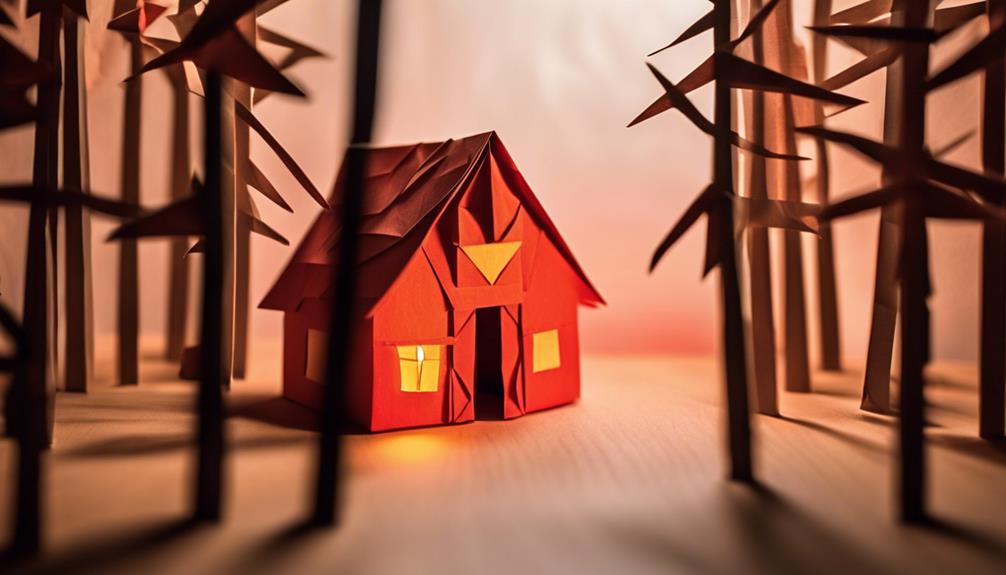Imagine your home as a fortress amidst a sea of dry kindling, where a single spark could ignite a devastating inferno. In rural areas, the threat of fire is a constant reality that must be met with preparedness and vigilance. From creating defensible space to fortifying your home with fire-resistant materials, there are crucial steps you can take to safeguard your property and loved ones. Stay tuned to discover essential fire safety measures tailored for homeowners in rural settings.
Understanding the Fire Risk

To fully comprehend the potential danger posed by wildfires, rural homeowners must assess the specific fire risk factors present in their area. Fire prevention should be a top priority. Start by inspecting your property for potential fire hazards. Clear away dry vegetation, debris, and dead plants that could easily ignite. Regularly maintain your yard by mowing the grass and trimming overgrown bushes to reduce fuel for potential fires. Additionally, store firewood and other flammable materials at a safe distance from your home.
Emergency preparedness is equally crucial. Develop a family emergency plan that includes evacuation routes and a designated meeting point. Ensure that all family members are aware of the plan and practice it regularly. Stock up on essential supplies like water, non-perishable food, and first aid kits. Keep important documents in a fireproof safe or store digital copies in a secure location. Being prepared for a wildfire can make all the difference in ensuring the safety of your loved ones and your property.
Establishing Defensible Space
Assessing and mitigating fire risks around your rural property is crucial for safeguarding your home and loved ones, and establishing defensible space is a key aspect of proactive fire safety measures. To create a defensible space effectively, consider the following steps:
- Brush Clearing: Regularly clear dry vegetation, bushes, and debris around your property to reduce potential fuel for fires.
- Strategic Landscaping: Plant fire-resistant vegetation and maintain a well-irrigated zone around your home to act as a barrier against encroaching flames.
- Controlled Burning: Work with local authorities to conduct controlled burns in a safe and regulated manner to reduce excessive vegetation buildup.
- Community Outreach: Engage with neighbors to coordinate fire safety efforts, share resources, and collectively enhance the fire resilience of your area.
Installing Early Warning Systems

When ensuring the safety of your rural property, one essential step is installing early warning systems to alert you to potential fire threats promptly. Smoke alarms are a fundamental component of these systems, providing an immediate alert if smoke is detected, allowing you to take quick action to prevent a fire from spreading. Monitoring these alarms regularly ensures they are functioning correctly and are a vital part of your fire prevention strategy.
| Early Warning Systems | Benefits |
|---|---|
| Smoke Alarms | Immediate detection of smoke, facilitating early intervention. |
| Monitoring | Regular checks ensure proper functioning, enhancing overall safety. |
| Alerts | Prompt notifications enable quick response, preventing larger fires. |
Developing an Evacuation Plan
In preparing for potential fire emergencies on your rural property, it is crucial to create a detailed evacuation plan that outlines clear routes and designated meeting points for all occupants. When developing your evacuation plan, consider the following:
- Identify Primary and Secondary Evacuation Routes: Map out the quickest paths to safety from different areas of your property.
- Communicate the Plan: Ensure all household members understand the evacuation routes and meeting points.
- Designate Safe Meeting Points: Choose specific locations where everyone will gather after evacuating to ensure accountability.
- Practice Regularly: Conduct drills to familiarize everyone with the evacuation plan, making sure each person knows their roles and responsibilities.
Having well-defined evacuation routes and a solid communication plan can significantly improve your chances of safely evacuating in the event of a fire. Regular practice will help everyone feel more confident and prepared for any emergencies that may arise.
Implementing Fire-Resistant Construction

To enhance the fire safety of your rural property, consider incorporating fire-resistant construction methods to mitigate the risk of potential fire hazards. When building or renovating your home in a rural area, choosing the right building materials and implementing fireproofing techniques can make a significant difference in wildfire prevention. Structural design also plays a crucial role in ensuring your property is better equipped to withstand fires. Here is a simple guide to help you make informed decisions:
| Building Materials | Fireproofing Techniques | Structural Design |
|---|---|---|
| Metal Roofing | Fire-Resistant Coatings | Defensible Space |
| Cement Board Siding | Fireproof Insulation | Ember-Proof Vents |
| Tempered Glass Windows | Sealing Wall Cavities | Non-Combustible Fencing |
Maintaining Fire Safety Equipment
Considering the importance of safeguarding your rural property against fire hazards, ensuring the proper maintenance of fire safety equipment is essential for optimal protection. Here are four key practices to help you maintain your fire safety equipment effectively:
- Routine Inspections: Regularly inspect all fire safety equipment such as smoke detectors, fire extinguishers, and sprinkler systems to ensure they are in working condition.
- Timely Repairs: Address any issues or malfunctions detected during inspections promptly to keep the equipment functioning correctly.
- Professional Servicing: Schedule professional maintenance services for specialized fire safety equipment like fire alarms or suppression systems to guarantee their effectiveness.
- Replacement Schedule: Keep track of the expiration dates on fire extinguishers and smoke alarms, replacing them as needed to maintain optimal safety levels.
Frequently Asked Questions
How Can Homeowners Protect Their Pets During a Wildfire Evacuation?
When evacuating during a wildfire, safeguarding your pets is crucial. Remember to have a pet emergency kit ready. Symbolically, pets are your family, so treat them as such. Plan ahead by identifying pet-friendly shelters in your area. Prioritize your furry friends' safety by keeping them leashed or crated for easy transport. Wildlife can be a threat during evacuations, so be cautious. Ensure your pets have proper identification and are microchipped for their safety.
Are There Any Specific Insurance Considerations for Homeowners in Rural Areas Prone to Wildfires?
When living in rural areas prone to wildfires, specific insurance considerations are crucial. Ensure your insurance coverage includes wildfire protection to safeguard your property. Prioritize property protection measures like creating defensible space and maintaining fire-resistant landscaping. Additionally, focus on emergency preparedness by having evacuation plans in place and organizing important documents. Stay informed about local fire risks to make informed decisions and mitigate potential damages.
What Are Some Common Mistakes That Homeowners Make That Increase Their Fire Risk?
When it comes to fire risk, some common mistakes homeowners make include neglecting fireproof landscaping and using non-fire-resistant building materials. Additionally, not practicing home evacuation drills and having an emergency communication plan can increase your vulnerability. By incorporating these practices, you can significantly reduce the risk of fire damage to your property and keep your loved ones safe in case of emergencies.
How Can Homeowners Safely Store Flammable Materials Such as Propane Tanks on Their Property?
When storing propane tanks on your property, safety precautions are key. Ensure tanks are stored upright in a well-ventilated area, away from heat sources or ignition points. Keep them clear of flammable materials and vegetation. Regularly inspect tanks for leaks or damage. Have a fire extinguisher nearby and know how to use it. Following these guidelines will help you safely store propane and reduce the risk of fire hazards on your property.
Are There Any Resources Available for Homeowners in Rural Areas to Receive Financial Assistance for Implementing Fire Safety Measures?
When you're looking to safeguard your homestead against the fiery beast, you might wonder about financial aid. Well, fear not, for there are government grants waiting to be discovered. These grants can be your knight in shining armor, helping you fortify your castle against the flames. Additionally, seek out community partnerships; they can be the secret passage leading you to resources and support in your quest for fire safety.



